Introduction
Types of indoor sports have steadily gained popularity over the years, providing an excellent alternative to outdoor activities. Whether due to weather conditions or a preference for a controlled environment, indoor sports offer an accessible way for people to stay active and competitive year-round.
These sports range from high-intensity team games like basketball to more relaxed pursuits such as yoga or board games. The diversity in activities ensures that there is something for everyone whether you’re looking to break a sweat or enjoy a casual game night with friends. Indoor sports cater to all ages and skill levels, making them a versatile and inclusive option for both physical and mental stimulation.
Section 1: What Defines an Indoor Sport?
Indoor sports are activities played within enclosed spaces, offering controlled environments that aren’t affected by outdoor elements like weather. This allows players to engage in sports consistently throughout the year, regardless of season or external conditions.
There are a few key factors that help categorize indoor sports:
Equipment: The gear required for the sport plays a significant role in defining the type of activity, whether it involves a ball, a racket, or even a climbing wall.
Number of Players: Indoor sports can range from individual activities, such as boxing or yoga, to team-based sports like futsal or volleyball, which require coordination among players.
Competition Style: Some indoor sports emphasize direct competition between players or teams, such as table tennis or basketball, while others focus on individual skill and precision, like darts or snooker.
By understanding these elements, we can break down indoor sports into distinct categories, each offering unique experiences for players.
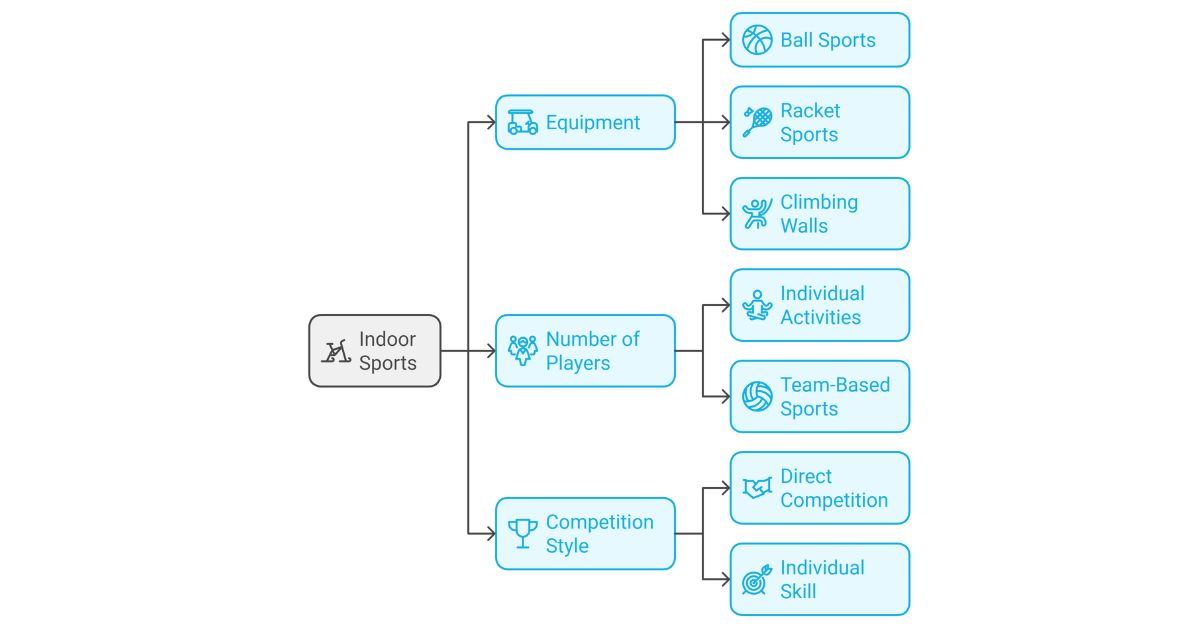
Section 2: Types of Indoor Sports
2.1. Team Sports
Team-based indoor sports involve two or more teams competing against each other to achieve a common goal. These sports require players to work together, relying on strategic teamwork and communication to outscore or outperform the opposing side. The fast pace and competitive spirit of team sports make them highly engaging, often requiring both physical endurance and mental coordination.
Examples:
Basketball: Played between two teams, typically of five players each, basketball involves scoring points by shooting a ball through the opponent’s hoop. The game is fast-paced, with constant movement, quick passes, and the need for strong teamwork to defend and attack efficiently.
Volleyball: In volleyball, two teams are separated by a net, with each side working to score points by grounding the ball on the opposing team’s court. The game emphasizes agility, timing, and communication, as players must coordinate their attacks and defense to keep the ball in play.
Indoor Soccer (Futsal): A variant of soccer, futsal is played indoors on a smaller, enclosed field with fewer players (usually five per team). The confined space encourages quicker ball control and fast-paced gameplay, making it an exciting, high-energy sport.

2.2. Racket Sports
Racket-based indoor sports are characterized by the use of a racket or paddle to hit a ball or shuttlecock back and forth. These sports demand quick reflexes, precise control, and agility. They are typically fast-paced and can be played either individually or in pairs, offering both recreational and competitive opportunities.
Examples:
Badminton: Played with a shuttlecock, badminton involves hitting the shuttle over a net, with players aiming to land it in the opponent’s court. The sport demands agility and precision, as the shuttle can reach high speeds, making for dynamic rallies.
Squash: Squash is played in a four-walled court where players alternately hit a small rubber ball against the front wall. The ball must stay within designated areas, and the game is known for its fast pace, requiring players to react quickly and cover the court efficiently.
Table Tennis (Ping Pong): Table tennis is a fast-paced game played on a small table, where players use paddles to hit a lightweight ball back and forth. The compact playing area requires excellent hand-eye coordination, rapid reflexes, and precise control of the ball.
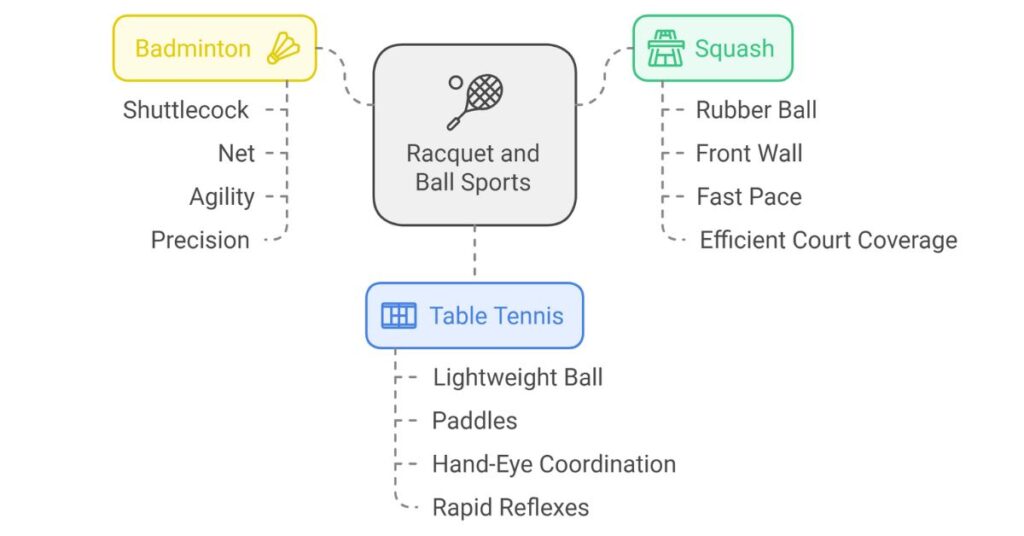
2.3. Combat Sports
Combat sports focus on martial arts and physical competition between opponents. These sports are often structured around disciplines of self-defense, grappling, and striking techniques, emphasizing both physical and mental strength. Combat sports can be highly technical, requiring years of training to master the skills necessary for competition.
Examples:
Boxing: In boxing, two opponents face off in a ring, aiming to outscore each other through punches while defending against attacks. Boxing is known for its combination of strength, speed, and tactical movement, with bouts consisting of timed rounds.
Judo: A grappling-based martial art, Judo focuses on throws, holds, and submissions to overcome an opponent. It emphasizes leverage, balance, and technique, rather than sheer force, making it a highly strategic sport.
Taekwondo: Originating from Korea, Taekwondo is a martial art that emphasizes high, fast kicks and quick footwork. The sport combines elements of speed, precision, and flexibility, with competitions focusing on striking and defensive techniques.
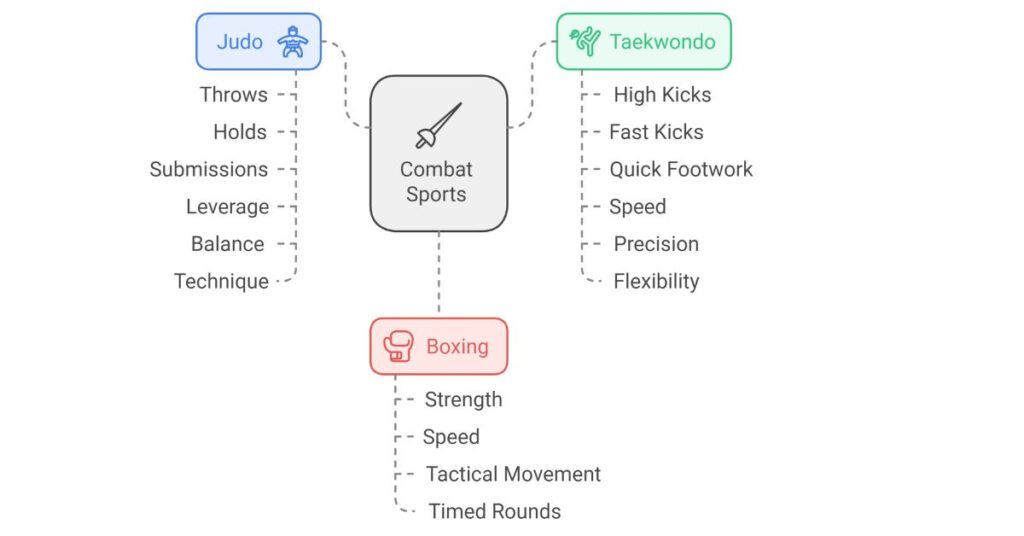
2.4. Precision Sports
Precision sports are centered around accuracy, focus, and fine motor skills. These sports often require participants to hit targets or achieve specific outcomes with careful aim and control, making them a test of both physical and mental dexterity. Precision sports can be competitive or recreational, appealing to players who enjoy honing their skill over time.
Examples:
Darts: In darts, players aim to throw small, pointed projectiles at a circular target marked with specific scoring zones. The objective is to hit high-scoring areas with precise throws, making it a game of both accuracy and strategy.
Bowling: In bowling, players roll a heavy ball down a lane with the goal of knocking down a set of pins at the end. Success in bowling depends on accuracy, technique, and the ability to consistently hit the target with the right force and angle.
Snooker/Pool: Both snooker and pool are cue sports played on rectangular tables with pockets. Players use a cue stick to strike balls into the pockets, with the objective varying based on the game type. These sports require careful shot selection, precision, and an understanding of angles to succeed.
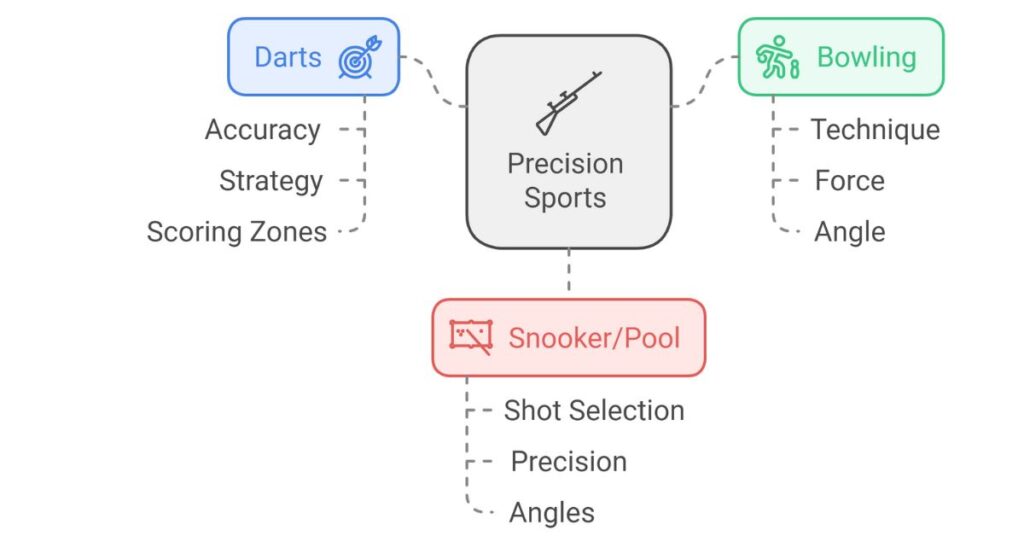
2.5. Fitness and Recreational Activities
Indoor fitness and recreational activities focus less on competition and more on physical health, well-being, and personal enjoyment. These activities are often designed to improve flexibility, strength, endurance, or mental clarity, and they can be enjoyed individually or in group settings.
Examples:
Yoga: A holistic practice that combines physical postures, controlled breathing, and meditation. Yoga aims to improve flexibility, strength, and mental calmness, making it a popular choice for stress relief and overall wellness.
Pilates: Pilates emphasizes controlled movements to strengthen the core muscles, improve flexibility, and enhance posture. The exercises are low-impact and focus on precision, making it suitable for individuals of all fitness levels.
Indoor Climbing: Indoor climbing involves scaling artificial rock walls of varying difficulty levels. It’s a physically demanding activity that builds strength, endurance, and problem-solving skills as climbers navigate routes designed to challenge their abilities.
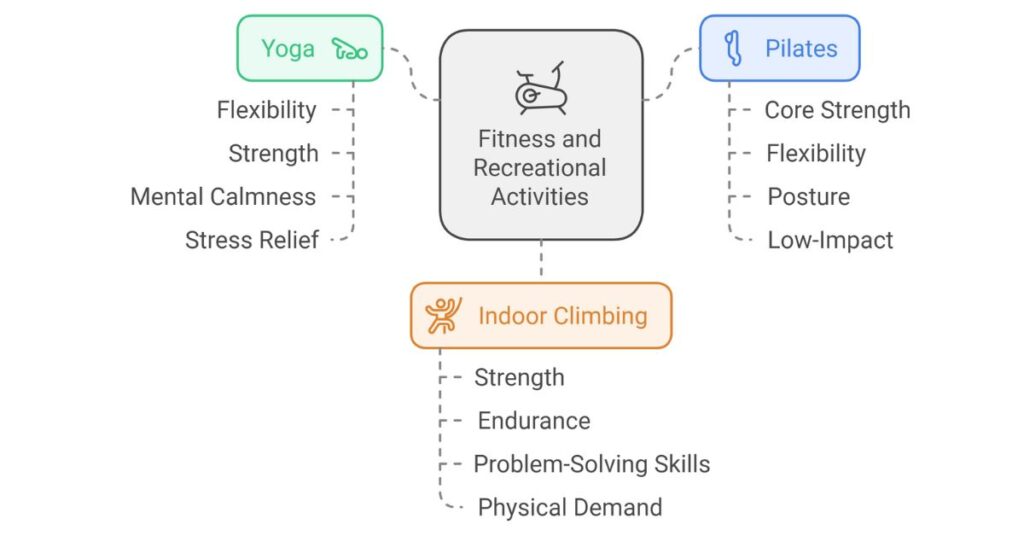
2.6. Other Indoor Games
Other indoor games often revolve around casual play, focusing on entertainment, mental challenge, or social interaction. These games can be competitive or purely for fun, making them great options for gatherings with friends or family. They require minimal physical exertion but still provide opportunities for strategic thinking, creativity, and camaraderie.
Examples
Charades: A classic party game where players act out words or phrases without speaking, while their teammates try to guess what they are miming. It’s a fun and interactive game that encourages creativity and quick thinking.
Board Games: Games like chess and checkers require strategy, foresight, and patience. Chess, in particular, is a mental challenge that demands players to think multiple moves ahead, while checkers offers simpler, yet still engaging, gameplay.
Card Games: Games like poker, bridge, and solitaire are popular in both casual and competitive settings. Poker and bridge require players to use strategy, probability, and psychology to outplay their opponents, while solitaire offers a solo gaming experience that challenges one’s problem-solving skills.

Conclusion on Types of Indoor Sports
Indoor sports offer an impressive variety, ranging from high-energy team sports to precision games and fitness-focused activities. Whether you’re looking to improve your physical fitness, engage in social interaction, or simply have fun, there’s an indoor sport to suit every taste. These activities allow participants to stay active and entertained, regardless of weather conditions, making them an accessible and enjoyable option year-round.
Indoor sports not only promote physical health but also foster teamwork, mental agility, and social bonding. Choosing an indoor sport that aligns with your preferences whether competitive or casual ensures that you’ll find something that fits your lifestyle while reaping both physical and mental benefits.
FAQ on Types of Indoor Sports
What are indoor sports?
Indoor sports are activities played within enclosed spaces, such as sports halls, gyms, or specialized facilities. These sports range from competitive team-based games like basketball and futsal to recreational activities like yoga and bowling.
Why are indoor sports popular?
Indoor sports are popular because they offer year-round opportunities for physical activity, regardless of weather conditions. They are also accessible to people of all ages and skill levels, making them versatile for both serious athletes and casual participants.
What are some examples of team-based indoor sports?
Some popular examples of team-based indoor sports include basketball, volleyball, and indoor soccer (futsal). These sports require players to work together to achieve a common goal, fostering teamwork and strategy.
What are racket sports, and what makes them unique?
Racket sports, such as badminton, squash, and table tennis, involve hitting a ball or shuttlecock with a racket or paddle. They are known for their fast-paced gameplay, which requires quick reflexes, precision, and agility.
Can indoor sports help improve fitness?
Yes, many indoor sports focus on improving physical fitness. Activities like Pilates, yoga, and indoor climbing build strength, flexibility, and endurance, making them excellent for maintaining overall health.
Are there indoor sports for people who prefer non-competitive activities?
Absolutely! There are plenty of non-competitive indoor activities such as yoga, Pilates, and board games. These options prioritize relaxation, mental wellness, and casual fun rather than intense competition.
What are precision sports, and what skills do they require?
Precision sports, such as darts, bowling, and snooker, focus on accuracy and skill. These sports often require fine motor control, hand-eye coordination, and the ability to stay focused under pressure.
How do I choose the best indoor sport for me?
Choosing the right indoor sport depends on your personal interests, fitness goals, and whether you prefer competitive or recreational activities. Start by considering what excites you most—whether it’s team-based games, solo fitness challenges, or casual, social activities.
Can I play indoor sports with minimal equipment?
Yes, many indoor sports require minimal equipment. For example, yoga only requires a mat, while card games and board games often need nothing more than a deck of cards or a game board. Even team sports like futsal or basketball are often played with just a ball and a court
Are indoor sports suitable for kids and seniors?
Indoor sports are suitable for all ages! Many sports and activities, such as badminton, yoga, and table tennis, can be adapted for different skill levels, making them safe and enjoyable for both children and seniors.






